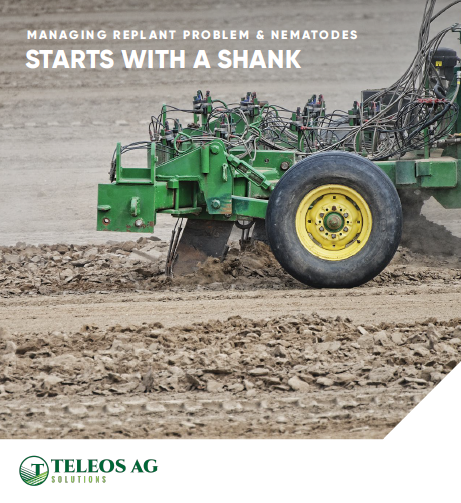High Density: The Future Of Almonds?
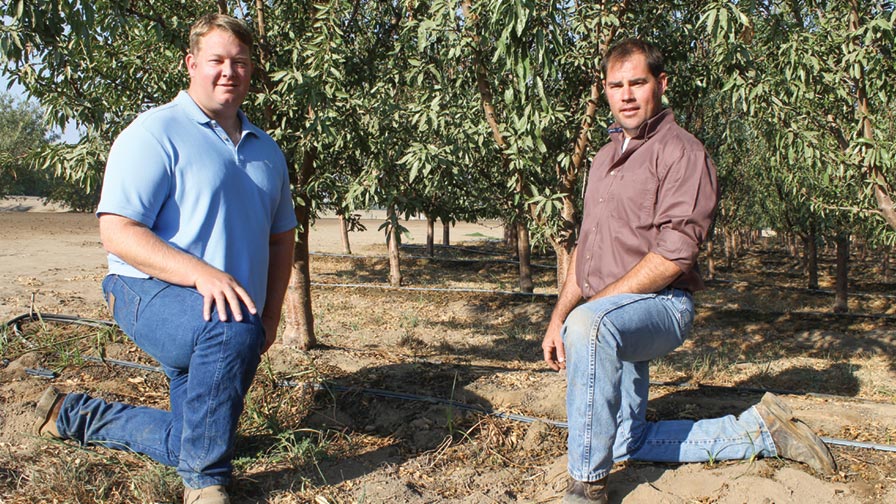
Billy Lyons, left, and his cousin, James Bogetti, show off the tight spacing (4 feet) of their trial block of ‘Independence’ almonds just west of Modesto, CA. (Photo credit: David Eddy)
Billy Lyons and his cousin James Bogetti fully understand why people have trouble wrapping their heads around the 10-acre trial block of almonds they’re farming just west of Modesto, CA. They planted a whopping 907 trees per acre on 12-by-4-foot spacing, after all, about six to nine times the density of conventional plantings.
“When you tell people about it, it sounds kind of ridiculous,” says Lyons.
Adds Bogetti: “We felt that way, too.”
Lyons says he had to go to Spain to see such a high-density almond planting for himself. Barcelona, Spain is where Agromillora is headquartered. The tree nursery company has locations all over the world, including California, where a friend of Lyons’, Cliff Little, works. Four years ago, Little flew Lyons back to Spain to see a trial block of almonds, because Little was convinced the concept could work in California.
Lyons came away impressed, and he too thought a high-density orchard system might work, especially planting a certain almond variety he’d already had some success with, ‘Independence.’ Of course, it didn’t hurt that the developer of the non-pollinated cultivar, Zaiger Genetics, is practically a neighbor of Lyons.
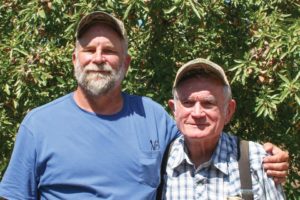
Grant Zaiger, left, and his dad, Floyd.
Lyons has long known Grant Zaiger, son of founder Floyd Zaiger, who couldn’t have agreed more strongly with the choice. Not just because of the lack of need for pollination, but because of the fruiting habits of ‘Independence.’
“Other almond varieties shade out nuts lower on the tree,” Zaiger says. “Look at [industry favorite] ‘Nonpareil.’ All its fruiting is in the top of tree. But ‘Independence’ has fruit from the top to the bottom.”
After discussing it with his family, Lyons planted the 10 acres of dwarfing trees that were provided in a collaboration between Agromillora and Dave Wilson Nursery, the master license holder of ‘Independence.’
Bumper Crops
The trial is now in its third leaf, and so far, so good.
“So far, it’s pretty astronomical seeing the nut-set this year,” Zaiger says. “He’s getting double what he gets from his normal plantings in the third leaf.”
Lyons says in the second leaf he got yields of 500 pounds per acre, but wouldn’t put too fine a point on his yields this year, except to say the block is yielding more than any other orchard of the same age in the surrounding area.
“It exceeded our expectations — the yields were a huge success,” he says. “It gave us a lot of momentum to continue the project, let’s put it that way.”
Lyons emphasizes that it’s still a work very much in progress. In fact, because of that, he was initially reluctant to discuss the project.
“It may work, it may not, which is why we were keeping it quiet — but with all the coffee shop talk,” he smiles, trailing off, before adding quickly: “As farmers we have to look to the future. If you don’t innovate and evolve, you may go extinct.”
Root Of The Matter
While ‘Independence’ appears to be an excellent choice for a variety to use in the project, the key to a high-density orchard lies with the rootstock. That’s why the whole project started with Agromillora, and its dwarfing rootstock, Rootpac 20.
Agromillora, which has 11 subsidiaries in 9 countries and produced more than 60 million finished trees and rootstocks last year, promoted its first high-density olive orchard 22 years ago and planted the first in California in 1998.
Little said the company has long produced high-density olives worldwide utilizing existing rootstocks, but saw a need to further develop a breeding program aimed at producing hybrid rootstock, not only for olives but also for other species.
Out of that original program, they developed a series of prunus rootstocks known as Rootpac. Each Rootpac rootstock was produced to manage a certain challenge to the grower. One, Rootpac 20, was bred to reduce the structure of the tree and gain the benefits of high-density, both in increased yields and lower labor inputs.
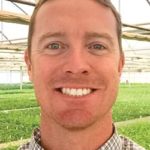
Cliff Little
“After olives we started looking at peaches, nectarines, and plums,” he says. “What other crops are scalable? What other crops would benefit from high density? There’s lots of almond acreage in Spain, but it’s not that productive. We knew stone fruit rootstocks could be compatible with almonds. So we started testing Rootpac 20 on almonds, and it looked great.”
In Europe more than 4,000 acres of high-density almonds have now been planted utilizing the main European varieties, and that number is expected to double over the next few years, Little says.
After the rootstocks went through quarantine in the U.S., Agromillora worked with Lyons and about a dozen other growers to establish trials in 2013 all over California, from as far north as Willows to as far south as Bakersfield.
The trials have gone well enough that some growers are doing additional plantings. Little encourages them to take a balanced approach to additional acreage.
“We’ve had quite a few orders already, with growers planting between 5 and 150 acres. What we tell growers is the information we have is the information we have,” he says. “We don’t have 15 years of data [here in California]. Anyone who wants to place an order for the coming year is welcome, but we tell them we simply don’t have long-term data on the rootstock/variety complement.”
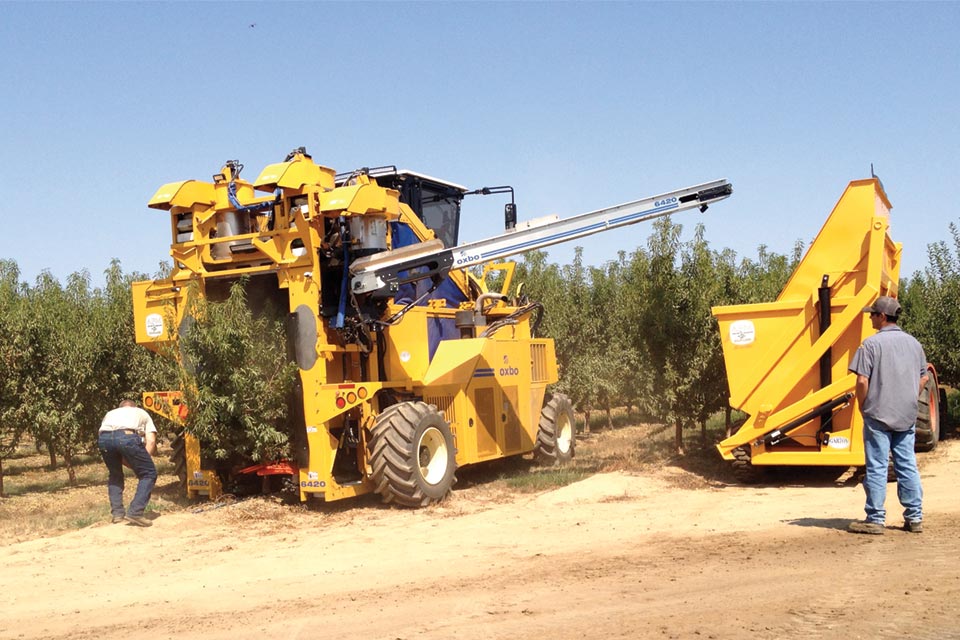
This modified olive harvester was used on the high-density block of almonds. (Photo credit: Billy Lyons)
Whole New Outlook
It’s a very different production system than a standard almond planting, Little emphasizes. The entire farming process can be mechanized and is very efficient due to the size of the trees, but growers need to understand that how you prune is much different. How you spray is different. How you irrigate is different. You can’t manage high-density almonds the same way you would farm conventionally.
“It’s such a different style of farming, there have been growing pains along the way,” he says. “For example, it takes smaller amounts of water, but more frequent irrigation sets. If the roots dry out, the tree can stress.”
In an effort to bring along growers more slowly to high-density farming, Agromillora tried the high-density model with standard rootstocks, Little says, but it quickly became apparent the standard rootstocks wouldn’t work.
“The dwarfing rootstock is the linchpin of the high-density program,” he says.
They’ve also been testing at least a dozen of the most well-known almond varieties on Rootpac 20. The best-yielding so far has been ‘Independence,’ mostly for the reason Lyons and Zaiger expected.
“The way it grows, it fits well with the system,” Little says. “It’s a rather compact variety. It tends to want to throw a lot of branches. ‘Aldrich,’ for instance, wants to go upright. Or ‘Monterey’ wants to open up. In these cases additional hedging in the orchard development is needed to promote lateral branching.”
But with all varieties, the concept of irrigation cannot be overemphasized.
Don’t Dry Them Out
Dwarfing rootstocks don’t grow as fast, and the roots don’t sink as deep, so deep watering doesn’t make sense, Little says. You need more of a “wetted band.”
For example, instead of a standard 24-hour irrigation set every 7 to 10 days, growers, during summer, should be irrigating for only 3 to 4 hours at a time, but 5 to 7 times per week.
“Having that proper irrigation is absolutely critical, because you are essentially establishing a hedge,” he says. “If you go a long time between watering, the trees can get so stressed they have trouble for rest of summer.”
As far as technique, some growers are utilizing dual-lined drip, and some are using microjet. Little hasn’t seen much difference. The real difference comes with completely changing your approach to irrigation if you go high-density.
“Billy (Lyons) has been successful because he created a separate irrigation system for the block,” Little says. “It’s a real key.”
As to whether growers can reduce the amount of water they use with a high-density system, Little says he has no definitive answer. That’s because while the water needs of each tree, once established, is less than a conventional tree, there are many more trees per acre.
“We’re still finding out just how much less water we can use,” he says.
No Dust To Bite
But perhaps the biggest difference with the high-density almond orchard is the grower doesn’t have to shake the nuts from the tree and later sweep them up; he has the option of harvesting the nuts directly from the tree. Lyons, for example, used a modified OXBO olive harvester this past fall supplied by Arata Farm Management.
“That’s one of the benefits of the high-density model, it gives you options,” Little says. “You can either harvest off the ground or off the tree. By harvesting from the tree you reduce the amount of dust. That’s one of those things we hadn’t really targeted in the trials but was brought to our attention by some of our growers.”
Little says they’re taking what they have learned harvesting olives and applying it to almonds, but almonds are actually easier.
“Olives don’t want to come off the tree, but almonds take much less force,” he says. “The initial harvesting we did on certain blocks did quite a bit of tree damage, because we were shaking the tree very hard with grape harvesters and using more bow rods than an almond
tree needed.”
Growers can reduce the force and the number of bow rods, or give it more of a shake like is done in a conventional orchard, and they have seen a reduction in tree damage with some minor changes.
“It’s not a conventional tree, so you can make a lot of adjustments,” he says. “We’re evaluating all harvesters on crops all over the world — coffee, blueberries, citrus. An olive harvester is being used right now, because it’s the most adaptable, but that doesn’t mean it will be used in the future.”
It’s important to remember that this is a new, wide-open field, Little says, and he expects all sorts of people to have great ideas on how high-density almond orchards are farmed, from machinery companies to pest control advisers. But the growers will have the most impact.
“We’re really confident in the growers of California. They’re not just good agronomists, they’re very intuitive. The growers are the ones who’ve come to us with ideas we have implemented in the newer trials,” he says. “The Lyons family epitomized this approach. They’ve listened, applied their own thinking, and they have set that block up really well.”
Future is Bright
However, it’s important to remember, say both Lyons and Bogetti, that the block is still just a trial block. While they have every reason to think it will be a success, they are taking a wait-and-see approach.
Grant Zaiger thinks it’s a matter of time.
“It remains to be seen on longevity, and the logistics of harvesting have to be done better,” he says. “But if it hits the 3,500-4,000 pound mark in a few years, it has a place.”
Lyons agrees, adding that if they weren’t getting comparable-to-increased yields, he wouldn’t have any reason to continue to farm the high-density block. Also, he has hedged his bets — with a nod to the growers of the prior generation (see “Synonymous With Success”).
“If this pilot is successful, it was James’ and my idea,” he says, before adding with a grin: “If not, it was my dad’s and my uncle’s idea.”

Billy Lyons, left, and James Bogetti are the fourth generation stewards of the famed Mape’s Ranch. Today the ranch is a model for sustainability and conservation. (Photo credit: David Eddy)
SIDEBAR: Synonymous With Success
The names Mape’s Ranch and Lyons are well-known to many Californians. The 10,000-acre ranch is located along Highway 132, which before the Interstate system was built, was the route everyone took from the Northern San Joaquin Valley to the San Francisco Bay Area. Many know the ranch from the big billboard on the highway, with its memorable slogan: “Breed The Best And Forget The Rest.”
The ranch was founded in 1923 by Edward Thomas Mape, who was the uncle of Billy Lyons’ grandfather, Bill Lyons Sr. Mape had no children, and asked Lyons to move out from Minnesota to work for him. Lyons later inherited the ranch in 1973, and when he passed away, the family continued the farming operation under the leadership of his wife, Mary Lyons, and sons Bill Jr. and Ed Lyons. Bill Jr. later served as secretary of the state Department of Food and Agriculture from 1999 to 2004.
His son, Billy Lyons, and his sister Lynne’s son, James Bogetti, are the fourth generation stewards. They help supervise the operation, which has evolved quite a bit over the years from its beginnings as a cattle ranch. In the 1980s, they diversified into alfalfa, corn, and tomatoes. In the ’90s, they began acquiring almond orchards and vineyards, and in 2010, led by Billy and James, they started developing their own almond orchards.
Today, Mape’s Ranch is also recognized as a shining example of sustainable ag. Besides maximizing water efficiency, the ranch, in a partnership with local food processors, utilizes fruit and vegetable waste as a soil amendment. Mape’s Ranch and the Lyons family have been recognized nationally by the U.S. Fish and Wildlife Service and other conservation organizations for their efforts in maintaining wildlife habitat. In fact, largely through their efforts, the Aleutian goose has been removed from the endangered species list.
SIDEBAR: High-Density Stone Fruit
Besides almonds, Agromillora’s Cliff Little says the company has conducted high-density trials in California on peaches – both fresh and cling – as well as nectarines, plums, and apricots. All trials utilized the dwarfing rootstock, Agromillora’s Rootpac 20.
“We feel it’s going to be a promising rootstock for the stone fruit industry. It won’t be too long before labor gets to the point where growers just aren’t able to make money,” he says. “And it’s not just the cost of the labor; everyone knows a grower who left something unpicked because he just couldn’t get the laborers out there to pick it.”
Using dwarfing rootstock reduces the size of trees and makes them easier to pick, but they still have to be picked. Because of that, Agromillora has been working with a lot of equipment companies in Europe, as well as OXBO here in the U.S.
Mechanized harvest might be the key to saving such processed fruit crops as cling peaches and prunes, which used to have mammoth profiles in California, but now are dwindling because of competition from cheap labor abroad.
“Lots of crops have gone high-density. Look at winegrapes or apples – a big portion of the market has converted to much higher densities,” he says. “One of the biggest factors in these crops was finding dwarfing rootstocks that work in higher densities, and that’s why we feel we can give growers an advantage with Rootpac 20.”
One thing is clear, stone fruit growers – especially in California where production costs are sky high – can’t just keep going as they have been.
“Change is coming. As the climate changes, as regulations change, as growers’ needs change – let’s face it, farming is an ever-changing environment and we need to adapt,” Little says. “We might not change how we farm today, or how we farm next year, but the concept (of high-density orchards) is something that has to be looked at it, because as time goes on, more growers are seeing the need for change.”






